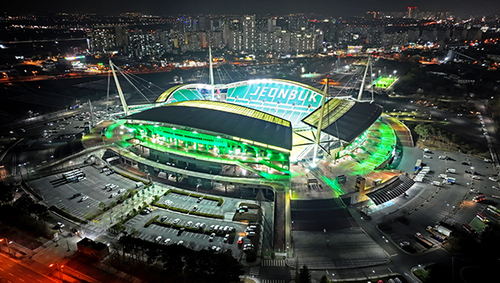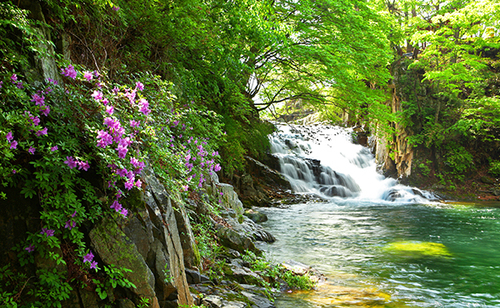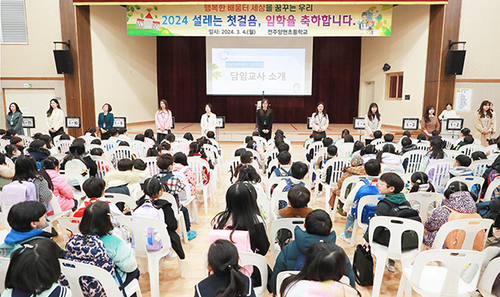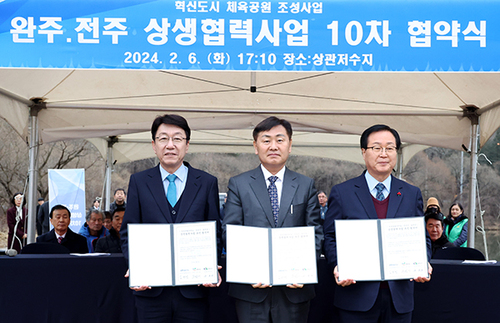| ▲ 전북 고창군 반암리에서 국내 초기 청자 도입과 전개과정을 밝힐 수 있는 '벽돌가마'와 '진흙가마'가 중첩되는 '아파트형 가마터'가 발견돼 유적 보존관리 및 국가사적 지정이 추진된다. / 사진제공 = 고창군청 © 김현종 기자 |
|
| ▲ 청자 ▲ 갑발 ▲ 도기 ▲ 기와 파편 등 출토된 유물. © 김현종 기자 |
|
전북 고창군 반암리에서 국내 초기 청자 도입과 전개과정을 밝힐 수 있는 '벽돌가마'와 '진흙가마'가 중첩되는 '아파트형 가마터'가 발견돼 유적 보존관리 및 국가사적 지정이 추진된다.
'반암리 청자요지'일원은 ▲ 용계리 청자요지(사적) ▲ 분청사기 요지(사적) ▲ 용산리 분청사기요지(道 기념물) 등 다수의 가마터가 밀집 분포하는 등 우리나라 도자 문화의 중심지로 인정받고 있다.
학계는 10세기 후반부터 오랫동안 운영됐고 대형 건물지까지 확인되면서 역사적ㆍ학술적 가치가 우수해 추가 발굴조사를 통해 사적 지정 가능성이 높은 것으로 분석했다.
고창군은 "지난해 가마터의 성격과 범위 등을 규명하기 위해 문화재청 긴급 발굴조사 지원 사업을 통해 (재)조선문화유산연구원이 '벽돌가마(전축요) 1기'와 '진흙가마(토축요) 4기ㆍ퇴적구릉ㆍ건물지 2동'등을 확인했다"고 14일 밝혔다.
특히 구릉의 하단부에서 대형 건물지가 확인됐다.
1호 건물지는 확인된 길이만 31m로 초기청자 생산과 관련된 공방 또는 감독관리시설로 판단되고 있다.
'벽돌가마'는 후대의 진흙가마와 중복돼 단면 상에서 일부 흔적이 확인됐으나 올해 진행한 발굴조사 결과, 조사 범위 가장 윗부분에서 가마의 소성부(燒成部 = 그릇을 두는 곳)와 연도부(燒成部 = 연기가 빠져나가는 곳)가 추가로 확인됐다.
노출된 '벽돌가마'는 길이 7.8mㆍ너비 2.7mㆍ바닥경사도 10° 내외로, 가마 축조는 구지표층을 사선으로 굴광한 다음 벽돌을 눕혀쌓았으며 가마 축조에 사용된 벽돌은 잔존 7단 정도고 3회 정도 개축해 운영했음이 밝혀졌다.
'진흙가마(2호~5호)'는 총 4기가 확인됐다.
2호 가마는 3~5호 가마와 중첩돼 있어 그 존재만 파악됐고 4호 가마가 폐기된 이후 5호가마가 만들어졌음이 확인됐다.
진흙가마는 부분적으로 결실됐으나 규모와 구조에서 동일한 양상을 보였고 길이 10~12mㆍ 너비 1.5~1.9m 정도며 화구(火口)는 석재를 4~5매 쌓은 후 양쪽에 기다란 석재를 세워 축조했다.
또, 불턱이 없어 연소부와 소성부의 구분이 명확하지 않으나 연소부에서 폭이 줄어들다가 소성부는 약간 넓어지는 양상이다.
또한, 건물지는 2기가 확인됐으며 조사구역 외곽까지 확장됐고 이 가운데 1호 건물지는 3호 가마에서 경사면 아래쪽으로 1.7m 정도 떨어져 기단 석렬ㆍ적심석ㆍ초석(礎石 = 주춧돌) 등이 일부 노출됐다.
건물 규모는 정면 3칸으로 추정됐고 주간거리는 2.7m 내외다.
유물은 ▲ 청자 ▲ 갑발 ▲ 도기 ▲ 기와 파편 등이 출토됐다.
청자는 해무리굽 완이 다수를 차지했고 독립문형 청자ㆍ화판형 접시ㆍ잔ㆍ주자ㆍ호 등도 소량 확인됐다.
갑발(匣鉢 = 불길과 재 등이 청자에 직접 닿지 않도록 청자 위에 씌우기 위해 점토로 만든 그릇)은 발형ㆍ복발형ㆍ원통형 등으로 갑발 받침과 뚜껑도 확인됐다.
갑발 바닥과 옆면에 특수한 형태의 문양(부호)이 확인돼 학계의 관심이 모아지고 있다.
유기상 고창군수는 "고창 반암리 청자 가마터를 통해 초기 청자의 발생과 변화과정ㆍ생산공정ㆍ관리체계까지 밝힐 수 있는 중요 자료로 평가되고 있는 만큼, 앞으로 진행될 조사 성과가 기대된다"며 "유적의 보존관리와 함께 국가사적 지정 추진에 행정력을 모으겠다"고 말했다.
충북대 이종민(문화재청 문화재위원) 교수는 "초기 청자 가마로써 보존상태가 매우 양호하고 벽돌가마에서 진흙가마로 변화 양상이 명확하게 확인되는 등 우리나라에서 매우 보기 드문 유적"이라고 평가했다.
한편 '벽돌가마'는 고려 수도인 개경(開京) 중심의 중부지역에서 주로 확인됐으나 최근 진안 도통리에서도 조사돼 사적으로 지정됐다.
☞ 아래는 위 기사를 구글 번역이 번역한 영문의 '전문'이다.
【Below is the 'full text' of an English article translated from the above article with Google Translate.】
Confirmation of 'Early Celadon Gamat' in Banam-ri, Gochang
Brick kiln(for livestock)ㆍmud kiln(for livestock)ㆍsedimentary hillsㆍbuilding sites etc.
Reporter Kim Hyun-jong
In Banam-ri, Gochang-gun, Jeollabuk-do, a 'brick kiln' and an 'apartment-type kiln' overlapping the 'mud kiln', which can reveal the introduction and development of celadon in the early days of Korea, was discovered, and the preservation of the remains and designation of a national historic site are being promoted.
The area of'Banam-ri Celadon Yoji' is recognized as the center of Korean ceramic culture, including ▲ Yonggye-ri Celadon Yoji(historic site) ▲ Bunchong Sagi Yoji (Historic Site) ▲ Yongsan-ri Bunchong Sagi Yoji(Provincial Monument).
Academia has been operating for a long time since the second half of the 10th century, and as large-scale buildings have been identified, the historical and academic value is excellent.
Gochang-gun said, "In order to identify the nature and scope of the kiln last year, through the Ministry of Cultural Heritage Administration's emergency excavation support project, the Chosun Cultural Heritage Research Center has been On the 14th, it was revealed on the 14th that "we have confirmed the two buildings of the old, sedimentary hills, and buildings."
In particular, a large building site was identified in the lower part of the hill.
Building No. 1 has a confirmed length of 31m and is considered a workshop or supervisory management facility related to the initial celadon production.
'Brick kiln' overlapped with later mud kiln and some traces were confirmed on the cross section.(成部 = where the smoke escapes) was additionally confirmed.
The exposed 'brick kiln' is 7.8m long, 2.7m wide, and a floor inclination of about 10°. For the kiln construction, the old surface layer was dug diagonally and then the bricks were laid and stacked, and the remaining bricks used for the kiln construction were about 7 levels. It turned out that it was renovated and operated three times.
A total of 4 'Mud Kilns(No. 2-No. 5)' were confirmed.
Kiln No. 2 overlapped with Kiln No. 3-5, so only its existence was identified, and it was confirmed that Kiln No. 5 was built after the No. 4 kiln was abandoned.
The clay kiln was partially fruited, but showed the same pattern in size and structure, and was 10-12m long and 1.5-1.9m wide. The crater was constructed by stacking 4-5 sheets of stone and elongated stone on both sides.
In addition, the division of the combustion section and the firing section is not clear because there is no fire pit, but the width decreases in the combustion section and then the firing section slightly widens.
In addition, two units of the building site were identified and expanded to the outskirts of the investigation area, and among them, building No. 1 fell 1.7m below the slope from the kiln No. 3, and some of the stone columns, red heart stones, and cornerstones were exposed.
The size of the building is estimated to be 3 squares in front, and the daytime distance is around 2.7m.
Relics ▲ celadon ▲ armor ▲ pottery ▲ tile fragments were excavated.
Celadon porcelain was occupied by Haemurigupwan, and a small amount of celadon-type celadon, drawing board-type plates, cups, runners and hos were also confirmed.
Gapbal(匣鉢 = a bowl made of clay to cover the celadon so that flames and ashes do not directly touch the celadon) have a foot shape, a double foot shape, a cylinder shape, etc., and the base and lid were also confirmed.
A special pattern(sign) has been identified on the bottom and side of the upper foot, attracting attention from the academic world.
Gochang-gun said, "As it is evaluated as an important data that can reveal the initial celadon occurrence and change process, production process, and management system through the celadon kiln in Banam-ri, Gochang, we are looking forward to the results of future investigations." Together, we will gather administrative power to promote the designation of national historic sites."
Chungbuk National University Professor Lee Jong-min(Cultural Property Commissioner of the Cultural Heritage Administration) said, "As an early celadon kilns, the preservation condition is very good, and the change from brick kilns to mud kilns is clearly confirmed, which is very rare in Korea."
Meanwhile, 'brick kiln' was mainly identified in the central region of Gaegyeong, the capital of Goryeo, but was recently investigated in Doton-ri, Jinan, and designated as a private site.






















 많이 본 뉴스
많이 본 뉴스











